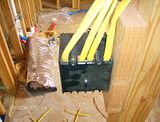In 2006 IRC, E3805.3.2 and 2005 NEC, 314.17 ©; "All permitted wiring methods shall be secured to the (nonmetallic) boxes"; with the exception of nonmetallic boxes that are not larger than 2 1/4" X 4" nominal.
In other words; the cable is required to be secured to the box.
Electric nonmetallic box manufacturers use various different methods of supplying a "built in" plyable self-securing tab openings.
I find that in most instances these tab openings are "knocked out" and, rendered useless.
Here is a picture of a box with the "self securing tabs" punched out;
(right click on picture to enlarge)

Are you inspecting and enforcing this requirement?
Uncle Bob
In other words; the cable is required to be secured to the box.
Electric nonmetallic box manufacturers use various different methods of supplying a "built in" plyable self-securing tab openings.
I find that in most instances these tab openings are "knocked out" and, rendered useless.
Here is a picture of a box with the "self securing tabs" punched out;
(right click on picture to enlarge)

Are you inspecting and enforcing this requirement?
Uncle Bob
